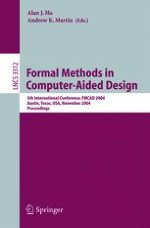2004 | Buch
Formal Methods in Computer-Aided Design
5th International Conference, FMCAD 2004, Austin, Texas, USA, November 15-17, 2004. Proceedings
herausgegeben von: Alan J. Hu, Andrew K. Martin
Verlag: Springer Berlin Heidelberg
Buchreihe : Lecture Notes in Computer Science
Enthalten in: Professional Book Archive
